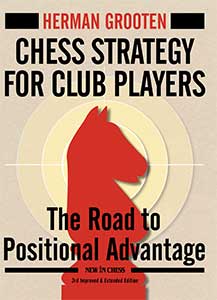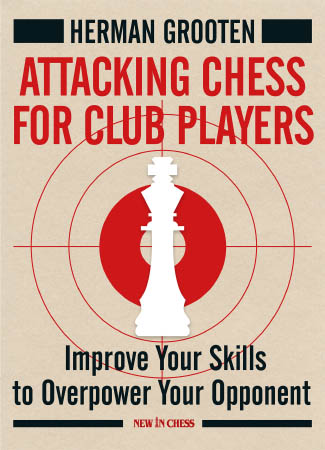My career as an author did not come completely out of the blue. I have always loved writing, but there was another important argument that I gained from the practice of teaching chess. After I started providing courses for club chess players and I also requested their games, I found out more and more about what most chess players struggle with. The big question they asked themselves was, “the opening is over, the opponent plays a move that is not familiar to me, how should I proceed?” I found out that most chess players who are quite knowledgeable about theory quite often also have no idea what the various positions are about. My conclusion was that I was better off covering the overall plans in the middle game in order to gain the necessary understanding needed to also make the right moves once the theory was over.
I was approached by the editor-in-chief of Schaakmagazine (the magazine of the Dutch Chess Federation) about whether I wanted to do a series of articles. This came at just the right time because I could review the outlines, concepts, and stereotypical maneuvers of many different openings, before only focusing on the various variants. Editor Thinkers Publishing (from Belgium) through an old chess friend, Daniël Vanheirzeele, gave me the chance to commit my thoughts on this to paper. Although I don’t have a good ready knowledge of openings myself, I dare say I can increase understanding by showing the various pawn structures in a schematic way. So instead of complicated and complex variants, more explanation is given using pawn structures and an inventory of the various specific plans belonging to a particular variant. Sometimes even a trip to a late middlegame or an endgame is made to understand how best to develop one’s pieces in the opening. The new series called “Understanding before Moving” was born! It also led to a weekly based video lesson on the portal of Chessbase.

It seemed to me that in the field of the ‘big openings’ (Ruy Lopez, Italian, Damegambiet, Sicilian, etc.) a gap had opened up because most opening books mainly cough up variants that the average club chess player cannot get through. Therefore, I thought it would be a good idea to start discussing precisely these systems in the way described above. To see whether this would be interesting for a certain audience, I organized a presentation in my own hometown with a reader attached, which I handed out afterward. At this try-out on a weekday evening in Eindhoven, almost 50 people signed up, an unprecedented number! The feedback I got from some people was that the evening went by way too fast! What better wish could a presenter have than this kind of positive criticism?
In the end, a whole series of books came about in which I also gave several presentations, and almost always the room was packed. I had previously been approached by the then director of the Dutch editor, New in Chess represented by Mr. Allard Hoogland, whether I would also like to write some books for this publisher. The initial contact led to the later award-winning book “Chess Strategy for Club players“. This book is mainly hung up on Steinitz’s “table” which is widely regarded as the elements of chess strategy. The book has already been printed in the third version and translated into German and Italian languages.
Meanwhile, I was working steadily on a second book, “Attacking Chess for Club Players” using much of the training material that I had collected together with my girlfriend, FM Petra Schuurman – with whom I had co-founded our own company (Sterk Spel “Dutch for Strong Play”) for over 10 years. We both gave a lot of training to various age groups and managed to organize and elaborate many tactical topics into learning materials at various levels. After the training material was further developed, the book with many exercises was published. So this book had a totally different approach and was also excellently received.
The promise was that I would write at least a third book and that became “Chess Endings for Club Players“. Before I got around to writing this at all, I first (re)organized the 45 years of training work on my hard drive. This led to a large collection of endgames. The main intention I had was to eliminate the great distaste many club chess players have for the endgame. In doing so, I was speaking from my own experience. In my youth, when I sat bent over several endgame books (including Averbakh’s) with a chess friend two years my senior, we immediately noticed that it was ‘tough stuff’. It led to us not completing every book….
Later, when, as a stronger chess player, I delved into endgames again, I found out more and more that entire move sequences are sometimes incomprehensible to a post-playing reader. To understand more of it, you actually want more advice from the author. And that is precisely what I started doing in this book. It is hung up on “techniques” and “rules of thumb”. A chess player benefits more if he knows whether to cut off the enemy king horizontally or vertically, that the rook belongs behind the passed pawn, and so on. In doing so, I have tried to take the reader to the various anecdotal games I have played myself in my own practice. In this way, I hope to make the book a bit more lively, and in the meantime, I am getting positive reactions to this. 🙂
Together with Petra we have one son, Tommy Grooten, who is born in 2010. In the meanwhile he already achieved several Dutch junior titles (U7, U9, U10, U12) and was invited by the Dutch Chess Federation to compete in two World Cadettes Championships (U8 in Spain in 2018 and U12 in Georgia in 2022).

Have any thoughts or questions? Let us know in the comments below!

Herman Grooten, born in July 1958 in Curaçao (The Netherlands Antilles), was raised in the Netherlands and started playing chess actively from the age of 14. He became an IM in 1990. He has since been a chess trainer/coach for more than 40 years. His chess students included Loek van Wely, Dennis de Vreugt, Jan Werle, Wouter Spoelman, Robin Swinkels, Twan Burg, and Benjamin Bok, all of whom became (strong) grandmasters. As an author of chess books, he now has quite a few to his credit. His book “Chess Strategy for Club Players” was crowned “Book of the Year” in 2009.
Photo Credit: Harry Gielen
- The Power of Pattern Recognition: The Woodpecker Method 2 - August 20, 2024
- Rock Solid Chess: Volume 2 - February 21, 2024
- Unsung Heroes of Chess - February 19, 2024



